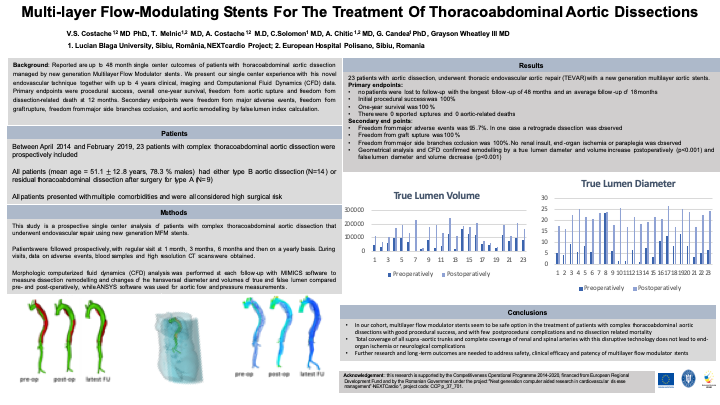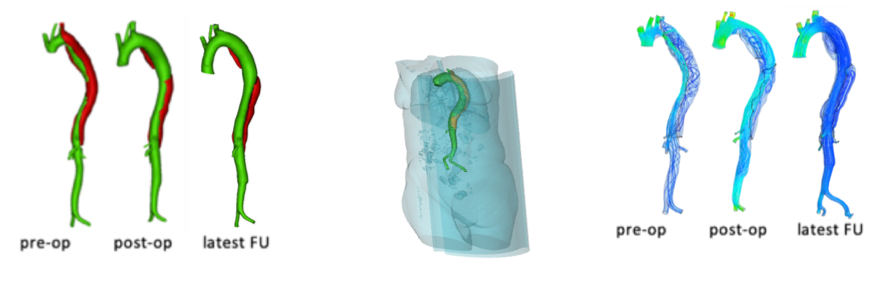Multilayer Stent For Acute and Chronic Aortic Dissections Research Poster (ISMICS)
For those of you who aren’t familiar with the multi-layer flow-modulating stent technology (MFM) for treating aortic aneurysms and aortic dissections, you should take the time to learn more about this novel and disruptive technology.
This technology is produced by a medical device company out of Europe called Cardiatis.
The multi-layer flow modulated stent technology takes advantage of the flow dynamics of blood as it interacts with the wire frame of the stents.
This technology is not yet available in the United States, but is available in Europe.
Recently, we presented the results and outcomes of using the multi-layer Flow-Modulating Stents to treat aortic dissections involving the thoracoabdominal aorta and the aortic arch at The International Society of Minimally Invasive Cardiothoracic Surgery 19th Annual Meeting in New York, NY.
This work was done in association with Dr. Victor Costache in Sibiu, Romania at the NEXTCardio Research Institute and the Polisano Clinic.

Victor Costache, Ovidiu Stiru, Kak Yeung, Andreea Costache, Crina Solomon, Tatiana Melnic, Mihai Sandu, Rodney White, Grayson H. Wheatley III
Background: Reported are up to 48 month single center outcomes of patients with thoracoabdominal aortic dissection managed by new generation Multilayer Flow Modulator stents. We present our single center experience with this novel endovascular technique together with up to 4 years clinical, imaging and ComputanionalFluid Dynamics (CFD) data. Primaryendpoints were procedural success, overall one-year survival, freedom from aortic rupture and freedom from dissection-related death at 12 months. Secondary endpoints were freedom from major adverse events, freedom from graft rupture, freedom from major side branches occlusion, and aortic remodelling by false lumen index calculation.
Patients: Between April 2014 and February 2019, 23 patients with complex thoracoabdominalaortic dissection were prospectively included. All patients (mean age = 51.1 ±12.8 years, 78.3 % males) had either type B aortic dissection (N=14) or residual thoracoabdominaldissection after surgery for type A (N=9). All patients presented with multiple comorbidities and were all considered high surgical risk.
Methods: This study is a prospective single center analysis of patients with complex thoracoabdominalaortic dissection that underwent endovascular repair using new generation MFM stents. Patients were followed prospectively, with regular visit at 1 month, 3 months, 6 months and then on a yearly basis. During visits, data on adverse events, blood samples and high resolution CT scans were obtained. Morphologic computerized fluid dynamics (CFD) analysis was performed at each follow-up with MIMICS software to measure dissection remodellingand changes of the transversal diameter and volumes of true and false lumen compared pre- and post-operatively, while ANSYS software was used for aortic flow and pressure measurements.

Results: 23 patients with aortic dissection, underwent thoracic endovascular aortic repair (TEVAR) with a new generation multilayer aortic stents.
Primary endpoints:
•no patients were lost to follow-up with the longest follow-up of 48 months and an average follow-up of 18 months
•Initial procedural success was 100%
•One-year survival was 100%
•There were 0 reported ruptures and 0 aortic-related deaths
Secondary end points:
•Freedom from major adverse events was 95.7%. In one case a retrograde dissection was observed
•Freedom from graft rupture was 100%
•Freedom from major side branches occlusion was 100%. No renal insult, end-organ ischemia or paraplegia was observed
•Geometrical analysis and CFD confirmed remodelling by a true lumen diameter and volume increase postoperatively (p<0.001) and false lumen diameter and volume decrease (p<0.001)


Conclusions: In our cohort, multilayer flow modulator stents seem to be safe option in the treatment of patients with complex thoracoabdominal aortic dissections with good procedural success, and with few post-procedural complications and no dissection related mortality
•Total coverage of all supra-aortic trunks and complete coverage of renal and spinal arteries with this disruptive technology does not lead to end-organ ischemia or neurological complications
•Further research and long-term outcomes are needed to address safety, clinical efficacy and patency of multilayer flow modulator stents
Was this post informative?
Subscribe to my newsletter to learn more about the aorta, its diseases, and how to treat them.
Comments
Share your thoughts below — I try to get back to as many comments as possible.